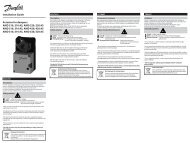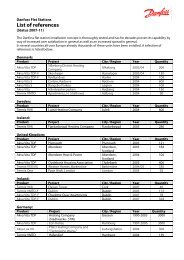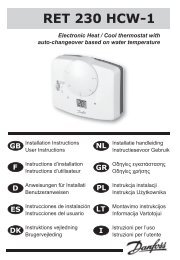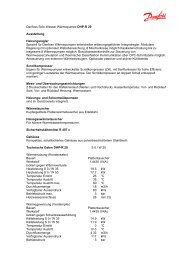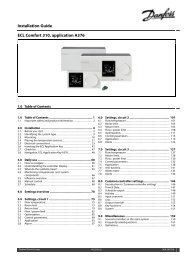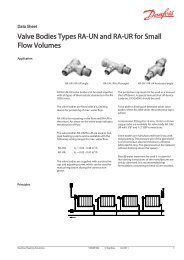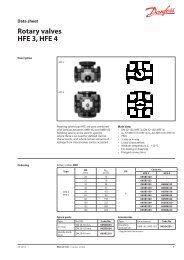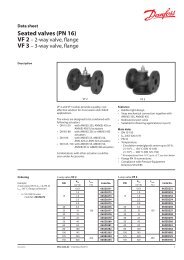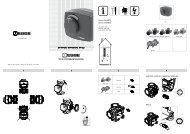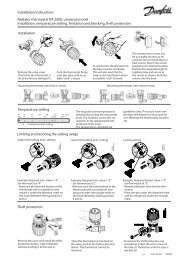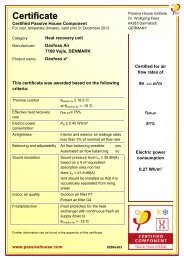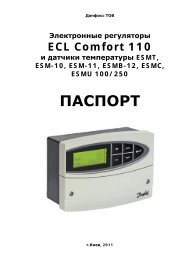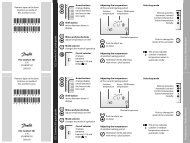Differential pressure controllers as a tool for ... - Danfoss.com
Differential pressure controllers as a tool for ... - Danfoss.com
Differential pressure controllers as a tool for ... - Danfoss.com
Create successful ePaper yourself
Turn your PDF publications into a flip-book with our unique Google optimized e-Paper software.
MAKING MODERN LIVING POSSIBLE<br />
Technical paper<br />
<strong>Differential</strong> <strong>pressure</strong> <strong>controllers</strong> <strong>as</strong> a <strong>tool</strong><br />
<strong>for</strong> optimization of heating systems<br />
Herman Boysen, Product Application Manager, <strong>Danfoss</strong> A/S<br />
Published in Euro Heat & Power 1/2003<br />
districtenergy.danfoss.<strong>com</strong>
TECHNICAL PAPER<br />
<strong>Differential</strong> <strong>pressure</strong> <strong>controllers</strong><br />
<strong>as</strong> a <strong>tool</strong> <strong>for</strong> optimization<br />
of heating systems<br />
One of the preconditions <strong>for</strong> a wellfunctioning control of a heating system<br />
is the correct choice of differential <strong>pressure</strong> controller <strong>for</strong> the control of the<br />
differential <strong>pressure</strong> across a heating system.<br />
If the differential <strong>pressure</strong> controller<br />
is not chosen correctly, you risk the<br />
following malfunctions:<br />
1. The function does not live up to<br />
its intention<br />
2. Bad functioning of the control<br />
equipment<br />
3. Pressure oscillation in the system<br />
A differential <strong>pressure</strong> controller can<br />
be chosen in different <strong>com</strong>binations,<br />
i.e. with or without flow limitation and<br />
with flow control.<br />
To limit this size of this article only the<br />
subject differential <strong>pressure</strong> control<br />
is described here.<br />
<strong>Differential</strong> <strong>pressure</strong><br />
<strong>controllers</strong><br />
Application<br />
<strong>Differential</strong> <strong>pressure</strong> <strong>controllers</strong> are<br />
mainly used to create a constant<br />
differential <strong>pressure</strong> in a system<br />
independent of the variation of<br />
external <strong>pressure</strong> differential <strong>pressure</strong><br />
in the supply net and consumption<br />
in the system <strong>as</strong> well. <strong>Differential</strong><br />
<strong>pressure</strong> <strong>controllers</strong> also are very often<br />
used to create a hydraulic balance in<br />
a network.<br />
The mostly used applications <strong>for</strong><br />
differential <strong>pressure</strong> <strong>controllers</strong> are:<br />
• Balancing control in secondary<br />
systems<br />
• Control of differential <strong>pressure</strong><br />
across district heating house<br />
substations<br />
• Pressure and differential <strong>pressure</strong><br />
control in district heating networks<br />
Advantages in general<br />
If differential <strong>pressure</strong> <strong>controllers</strong> are<br />
used in a subscriber station, a constant<br />
differential <strong>pressure</strong> across the<br />
substation in static relation can be<br />
maintained regardless of variations in<br />
the network differential <strong>pressure</strong>.<br />
This benefits end-users of the house<br />
substation <strong>as</strong> well <strong>as</strong> the utility<br />
<strong>com</strong>pany.<br />
End-user advantages<br />
<strong>Differential</strong> <strong>pressure</strong> controller chosen<br />
to control the differential <strong>pressure</strong> in<br />
a substation enables the exact sizing of<br />
the control valve. This again offers<br />
improved control conditions <strong>for</strong> the<br />
control valves, which gives the<br />
following advantages <strong>for</strong> the end-user:<br />
Author(s)<br />
Herman Boysen,<br />
Product Application Manager, <strong>Danfoss</strong> A/S<br />
<strong>Danfoss</strong> District Energy, Nordborg, Denmark,<br />
+45 7488 4123 · boy@danfoss.<strong>com</strong><br />
• Stabilization of the temperature<br />
control. (Better valve authority and<br />
lower system gain).<br />
• Low noise level and reduced risk of<br />
cavitation in the control valve<br />
• Simple adjustment of the subscriber<br />
station<br />
• Prolonged life of the control<br />
equipment<br />
Utility <strong>com</strong>pany advantages<br />
Use of differential <strong>pressure</strong> <strong>controllers</strong><br />
in substations and in the district<br />
heating network will maintain<br />
a hydraulic balance in the network.<br />
This means:<br />
• A good distribution of water in the<br />
supply network (satisfied consumers)<br />
• The desired <strong>pressure</strong> level in the<br />
network can be achieved. Reduced<br />
risk of <strong>pressure</strong> oscillation in the<br />
network.<br />
• The quantity of circulating water in<br />
the network can be limited (reduced<br />
costs <strong>for</strong> water circulation)<br />
2 <strong>Danfoss</strong> District Energy
Technical Paper <strong>Differential</strong> <strong>pressure</strong> <strong>controllers</strong>…<br />
Control factors<br />
This article describes the influence<br />
a differential <strong>pressure</strong> controller h<strong>as</strong><br />
on a well-functioning district heating<br />
house substation. This influence h<strong>as</strong><br />
a big impact on the above-mentioned<br />
advantages.<br />
In order to provide a well-functioning<br />
system, knowledge of the following<br />
control factors is very important:<br />
1. Valve sizing<br />
1.1. Sizing of a motorized control<br />
valve<br />
1.2. Sizing of a differential <strong>pressure</strong><br />
controller<br />
1.3. Control ratio<br />
1.4. Per<strong>for</strong>mance ratio<br />
2. Adjustment of the system<br />
3. Noise in the control valve<br />
4. Hydraulic balance in the supply<br />
network<br />
4.1. Flow limitation<br />
4.2. Accuracy of the flow limitation<br />
1. Valve sizing<br />
The correctly selected valve size is the<br />
b<strong>as</strong>is of a stable temperature control<br />
of the heating <strong>as</strong> well <strong>as</strong> the domestic<br />
hot-water system.<br />
1.1 Sizing of a motorized<br />
control valve<br />
Imagine that you are going to size<br />
a control valve <strong>for</strong> a room heating<br />
system within a district heating system.<br />
The system is not equipped with<br />
a differential <strong>pressure</strong> controller<br />
see fig. 1.<br />
The per<strong>for</strong>mance of the system<br />
is 220 kW.<br />
With a temperature difference<br />
ΔT = 50 °C in the system, the flow rate<br />
in the system can be calculated <strong>as</strong><br />
Q = 1.05 l/sec ~ (3.78 m 3 /h).<br />
For the sizing of a control valve, the<br />
following equation <strong>for</strong> the k v calculation<br />
is used<br />
k<br />
v<br />
Q<br />
∆p<br />
k V = capacity of the valve [m 3 /h]<br />
Q = the needed flow rate through the<br />
valve [m 3 /h]<br />
ΔP V = differential <strong>pressure</strong> across the<br />
valve [bar]<br />
<strong>Danfoss</strong> District Energy<br />
v<br />
(1)<br />
FIGURE 1: Control of a room heating system with a motorized control valve but<br />
without a differential <strong>pressure</strong> controller<br />
Available min. expected ΔP supply in the<br />
network is:<br />
100 kPa (1 bar)<br />
ΔP across other equipment is<br />
calculated <strong>as</strong>:<br />
30 kPa (0.3 bar)<br />
The flow rate is calculated on a b<strong>as</strong>is<br />
of the per<strong>for</strong>mance of the system.<br />
The available differential <strong>pressure</strong> <strong>for</strong><br />
the motorized control valve can be<br />
more difficult to determine because of<br />
the <strong>pressure</strong> variation in the network.<br />
The differential <strong>pressure</strong> in the network<br />
can vary to such an extent that the<br />
available differential <strong>pressure</strong> <strong>for</strong> the<br />
control valve can be from<br />
1 bar up to 5 bar.<br />
At ΔP V 0.7 bar available <strong>for</strong> the valve,<br />
the calculated k V value <strong>for</strong> the valve<br />
will be:<br />
k<br />
v<br />
=<br />
3.<br />
78<br />
0.<br />
7<br />
=<br />
4.<br />
52<br />
m<br />
3<br />
/ h<br />
A control valve of DN 25 mm with<br />
a k VS = 6.3 m 3 /h will fit these conditions.<br />
Available differential <strong>pressure</strong> <strong>for</strong> the<br />
control valve ΔP V is:<br />
70 kPa (0.7 bar)<br />
The d ΔPv needed <strong>for</strong> this valve can<br />
now be calculated:<br />
∆p<br />
∆p<br />
v<br />
⎛<br />
=<br />
⎜<br />
⎝<br />
Q<br />
k<br />
vs<br />
⎞<br />
⎟<br />
⎠<br />
. 78<br />
6.<br />
3<br />
= bar<br />
If the ΔP in the network incre<strong>as</strong>es to<br />
5 bar, the ΔP available <strong>for</strong> the valve in<br />
the system is<br />
500 − 30 = 470 kPa (4.7 bar) and then<br />
the needed k V will only be:<br />
k<br />
v<br />
In this c<strong>as</strong>e a control valve of DN 15 mm<br />
with a k VS = 2.5 m 3 /h h<strong>as</strong> the sufficient<br />
capacity.<br />
From the calculation it can be seen that<br />
the DN 25 valve under max. capacity<br />
and max. ΔP will operate with<br />
k<br />
k<br />
v<br />
vs<br />
v<br />
⎛ 3<br />
= ⎜<br />
⎝<br />
=<br />
3.<br />
78<br />
4.<br />
7<br />
which is about one third of its max.<br />
capacity.<br />
2<br />
⎟<br />
⎠<br />
=<br />
0.<br />
36<br />
bar<br />
If the differential <strong>pressure</strong> of the system<br />
incre<strong>as</strong>es, the valve will start to close<br />
and operate on a lover part of the valve<br />
characteristic, see fig. 4.<br />
⎞<br />
6.<br />
3<br />
= =<br />
1.<br />
74<br />
2<br />
=<br />
1.<br />
74<br />
3.<br />
6<br />
m<br />
3<br />
/ h<br />
(2)<br />
3
Technical Paper <strong>Differential</strong> <strong>pressure</strong> <strong>controllers</strong>…<br />
1.2 Sizing of a differential <strong>pressure</strong><br />
controller<br />
If a differential <strong>pressure</strong> controller<br />
is chosen <strong>for</strong> the system, the valve<br />
calculation could be:<br />
Available min. expected ΔP in the<br />
network is:<br />
100 kPa (1 bar)<br />
ΔP across other equipment<br />
is calculated to:<br />
30 kPa (0.3 bar)<br />
ΔP across the control valve:<br />
30 kPa (0.3 bar)<br />
Available differential <strong>pressure</strong> <strong>for</strong> the<br />
valve ΔP V is:<br />
40 kPa (0.4 bar)<br />
Flow rate <strong>as</strong> control valve<br />
3.78 m 3 /h<br />
Control valve:<br />
k<br />
v<br />
=<br />
3.<br />
78<br />
0.<br />
3<br />
6.<br />
9<br />
m<br />
/ h<br />
Selected valve: DN 32 K VS 10 m 3 /h<br />
∆p<br />
The Δp V available <strong>for</strong> the differential<br />
<strong>pressure</strong> controller<br />
100 ÷ 30 ÷ 14 = 56 kPa (0.56 bar)<br />
k<br />
v<br />
=<br />
In this situation a differential <strong>pressure</strong><br />
controller of DN 25 and a k VS = 6.3 m 3 /h<br />
can be chosen.<br />
At a max. ΔP in the system, the<br />
differential <strong>pressure</strong> controller<br />
will operate with:<br />
ΔP V = 500 ÷ 30 ÷ 14 = 456 kPa (4.6 bar)<br />
k<br />
v<br />
v<br />
Fig. 3 illustrates that this valve<br />
will operate with a Xp band<br />
of ~ 5.9 kPa ~ (0.059 bar) and that<br />
the control deviation will be<br />
from ~5.9 kPa down to 1.9 kPa. The total<br />
control deviation during the <strong>pressure</strong><br />
variation from 1– 5 bar will then<br />
be 5.9 – 1.9 = 4 kPa.<br />
2<br />
⎛ 3.<br />
78 ⎞<br />
= ⎜ ⎟<br />
⎝ 10 ⎠<br />
=<br />
=<br />
3.<br />
78<br />
0.<br />
56<br />
3.<br />
78<br />
4.<br />
6<br />
=<br />
=<br />
=<br />
5.<br />
05<br />
1.<br />
76<br />
3<br />
0.<br />
14<br />
m<br />
m<br />
3<br />
3<br />
bar<br />
/ h<br />
/ h<br />
FIGURE 2: Control of a room heating system with a motorized control valve<br />
and a differential <strong>pressure</strong> controller<br />
Calculated kv (m3/h)<br />
12<br />
10<br />
8<br />
6<br />
4<br />
2<br />
0<br />
DN 20<br />
DN 15<br />
DN 20<br />
DN 25<br />
DN 32<br />
Control deviation Xp<br />
0,1 1 2 3 4 5 6 7 8 9 10<br />
Control deviation Xp (kPa)<br />
FIGURE 3: Xp band and control deviation Xp (kPa) of the <strong>Danfoss</strong><br />
differential <strong>pressure</strong> <strong>controllers</strong> type APV<br />
Kv (m3/h<br />
7,00<br />
6,00<br />
5,00<br />
4,00<br />
3,00<br />
2,00<br />
1,00<br />
0,00<br />
Valve opening at Max per<strong>for</strong>mance<br />
Without dP controller<br />
With dP controller<br />
0,5 1 1,5 2 2,5 3 3,5 4 4,5 5<br />
System differential Pressure (Bar)<br />
FIGURE 4: Valve opening related to the differential <strong>pressure</strong> in the system with<br />
and without differential <strong>pressure</strong> controller<br />
4 <strong>Danfoss</strong> District Energy
Technical Paper <strong>Differential</strong> <strong>pressure</strong> <strong>controllers</strong>…<br />
Now we will observe that if variations in<br />
the network ΔP are from 100 to 500 kPa,<br />
the variation of the ΔP v across the<br />
control valve in fig. 2 will only be<br />
Xp = 4 kPa. This means that if<br />
a differential <strong>pressure</strong> controller is<br />
installed in the system, it will almost<br />
keep the ΔP V constant independent of<br />
the variation of the differential <strong>pressure</strong><br />
in the network.<br />
Fig. 4 shows you the ratio between the<br />
needed capacity (k V ) and ΔP supply in<br />
the network with and without<br />
a differential <strong>pressure</strong> controller.<br />
The lower the capacity ratio in a system<br />
without differential <strong>pressure</strong> controller,<br />
the higher the risk <strong>for</strong> oscillation due to<br />
operation below k vr.<br />
To avoid oscillation in a system,<br />
the following h<strong>as</strong> to be taken into<br />
consideration:<br />
• Setting of the parameters in the<br />
electronic controller<br />
• Type of valve characteristics<br />
• Control ratio of the valve<br />
Controller setting<br />
Setting of the control parameters in the<br />
electronic controller is very important<br />
to avoid oscillation. The setting can be<br />
simplified by selecting of a controller<br />
with functions such <strong>as</strong> auto tuning and<br />
motor protection [3].<br />
Valve characteristics<br />
A control valve must have<br />
characteristics adapted to the operating<br />
actuator and the heating application.<br />
For room heating system and domestic<br />
hot-water systems, a split characteristic<br />
will be the optimum choice (fig. 5).<br />
The split characteristic is developed<br />
according to the heat exchanger<br />
efficiency typical <strong>for</strong> temperature<br />
sets used in district heating system<br />
applications [1] and [2].<br />
1.3 Control ratio<br />
The German re<strong>com</strong>mendation<br />
VDI/VDE 2173 states the rules of<br />
defining the control ratio of a valve.<br />
The control ratio is here defined <strong>as</strong> the<br />
relationship between the k VS and the k vr<br />
value of the valve. The definition of the<br />
control ratio R is:<br />
R = k vs/k vr<br />
<strong>Danfoss</strong> District Energy<br />
(3)<br />
FIGURE 5: Example of the split characteristic of a motorized control valve<br />
and the kvr value<br />
Per<strong>for</strong>mance ratio<br />
40<br />
35<br />
30<br />
25<br />
20<br />
15<br />
10<br />
5<br />
0<br />
Per<strong>for</strong>mance ratio P100/Pkv r, with and without a dP<br />
controller<br />
With differential <strong>pressure</strong> controller<br />
0,3 0,5 1 1,5 2 2,5 3 3,5 4 4,5 5<br />
<strong>Differential</strong> <strong>pressure</strong> dPv (Bar)<br />
FIGURE 6: Per<strong>for</strong>mance ratio depending of the differential <strong>pressure</strong> in the system.<br />
The calculation is b<strong>as</strong>ed on ΔT = 50 °C.<br />
k VS is the max. capacity of a given<br />
control valve, m 3 /h.<br />
k vr is the lowest capacity of the valve<br />
at which the slope of control<br />
characteristic is within a given<br />
tollerence.<br />
The text below explains that the higher<br />
a control ratio of a control valve, the<br />
better the control capability of the<br />
valve.<br />
From the point on the valve<br />
characteristic (fig. 5) corresponding to<br />
k vr and down to the closing point, the<br />
slope of the characteristic is very step.<br />
There<strong>for</strong>e the gain in the control loop<br />
(flow rate/lift of the valve) will be<br />
relatively high. As a result, the<br />
temperature control in a heat<br />
exchanger system and a mixing loop<br />
might cause hunting of the controlled<br />
temperature at opening degrees of the<br />
valve below the values that correspond<br />
with k vr .<br />
This means that the capacity<br />
corresponding to the capacity at k vr<br />
normally is the lowest degree of<br />
opening at which a stable control can<br />
be expected.<br />
5
Technical Paper <strong>Differential</strong> <strong>pressure</strong> <strong>controllers</strong>…<br />
Valves with a linear control ratio<br />
typically have a high control ratio,<br />
R = 100 – 200, where<strong>as</strong> the typical<br />
control ratio of exponential and<br />
logarithmic valves is R = 30 – 50.<br />
1.4 Per<strong>for</strong>mance ratio<br />
The definition of the per<strong>for</strong>mance ratio<br />
can be expressed <strong>as</strong> the ratio between<br />
the max. per<strong>for</strong>mance P 100 and the<br />
per<strong>for</strong>mance at k vr, P kvr at which there is<br />
a stable temperature control P 100/ P kvr.<br />
(fig. 6).<br />
The k V of the valve at 100% load<br />
depends on the differential <strong>pressure</strong><br />
across the valve. The higher the<br />
differential <strong>pressure</strong>, the lower the<br />
needed k v value at P 100, see fig. 4.<br />
Q min is according to the definition of the<br />
control ratio the lowest k v value of the<br />
valve at which the controlled<br />
temperature can be expected<br />
to be stable.<br />
If a differential <strong>pressure</strong> controller is<br />
used, the system can be set so that the<br />
valve operates with a k vs at P 100.<br />
For <strong>com</strong><strong>for</strong>t re<strong>as</strong>ons the temperature in<br />
a domestic hot-water system h<strong>as</strong> to be<br />
very stable. If an instantaneous<br />
hot-water system is chosen, it h<strong>as</strong> to be<br />
able to control a low capacity at<br />
a stable temperature.<br />
A relevant demand to the lowest<br />
capacity in a domestic hot-water<br />
system is that the temperature should<br />
be kept stable if one person takes<br />
a shower. In this c<strong>as</strong>e the min. required<br />
capacity would then be keeping the<br />
temperature stable in connection with<br />
a shower and at the same time<br />
<strong>com</strong>pensating <strong>for</strong> the heat loss due to<br />
the circulation of the domestic<br />
hot-water. A relevant capacity here<br />
depends on type of systems.<br />
In two-step instantaneous system<br />
where in wintertime the cold water is<br />
preheated of the return flow from the<br />
room system, a relevant needed flow<br />
rate <strong>for</strong> after heat the domestic hot<br />
water, will be 0.20 m 3 /h. [4]. In parallel<br />
systems an equivalent capacity will be<br />
0.33 m 3 /h.<br />
From fig. 7 it can be seen that this<br />
system equipped with a dP controller<br />
which can control this capacity. It also<br />
can be seen that the limit of dP v in<br />
a system without dP controller is app.1<br />
bar <strong>for</strong> two-step systems and 2.7 bar <strong>for</strong><br />
parallel systems.<br />
Flow rate (m 3 Flow rate (m /h)<br />
3 /h)<br />
0,50<br />
0,45<br />
0,40<br />
0,35<br />
0,30<br />
0,25<br />
0,20<br />
0,15<br />
0,10<br />
0,05<br />
Flowrate (m3/h) at kv kv r with and without dP controller<br />
Per<strong>for</strong>mance at hot w ater circulating and one show er paralell systems<br />
Min. controlled per<strong>for</strong>mance with differential <strong>pressure</strong> controller<br />
0,00<br />
0,3 0,5 1 1,5 2 2,5 3 3,5 4 4,5 5<br />
<strong>Differential</strong> <strong>pressure</strong> dP v (bar)<br />
FIGURE 7: Min. controlled flow rate depending of the differential <strong>pressure</strong> dP v<br />
dPv (P1-P2) across the valve (Bar)<br />
10<br />
9<br />
8<br />
7<br />
6<br />
5<br />
4<br />
3<br />
2<br />
1<br />
0<br />
FIGURE 8: Cavitation factor depending on P1 and Δp v<br />
2. Adjustment of the system<br />
Adjustment of a subscriber station<br />
ensures the highest possible degree<br />
of valve opening at 100% load.<br />
If a differential <strong>pressure</strong> controller is<br />
used in a system, a final adjustment can<br />
be done in an e<strong>as</strong>y and correct way.<br />
A stable temperature control is<br />
achieved when the control valve<br />
operates in the entire range<br />
of valve characteristic.<br />
This is the prior condition to gain full<br />
effect of the control ratio of the valve<br />
<strong>as</strong> the control ratio is calculated on the<br />
b<strong>as</strong>is of the kvs value of the control<br />
valve.<br />
Min controlled per<strong>for</strong>mance w ithout dP controller<br />
Limit <strong>for</strong> cavitation<br />
z = 0,6<br />
T = 100 °C<br />
1 2 3 4 5 6 7 8 9 10 11 12 13 14 15 16<br />
Pressure (P1) be<strong>for</strong>e the valve (Bar)<br />
Normally valves are sized by calculating<br />
the kv value on the b<strong>as</strong>is of the flow<br />
through the valve and a chosen<br />
<strong>pressure</strong> drop across the valve with due<br />
consideration to the valve authority.<br />
B<strong>as</strong>ed on the calculated kv value,<br />
a valve with a suitable kvs value is<br />
chosen, i.e. with a value which is often<br />
a bit higher than the calculated value.<br />
The adjustment procedure is then to<br />
set the differential <strong>pressure</strong> controller<br />
at a lower differential <strong>pressure</strong> so that<br />
the control valves are fully open at<br />
100% load. As it is often difficult to<br />
simulate a situation at 100% load, the<br />
setting <strong>pressure</strong> ΔP v can be calculated<br />
by means of the equation <strong>for</strong><br />
ΔP v (equation 2).<br />
6 <strong>Danfoss</strong> District Energy<br />
T = 55 °C<br />
T = 100 °C<br />
T = 55 °C
Technical Paper <strong>Differential</strong> <strong>pressure</strong> <strong>controllers</strong>…<br />
3. Noise in the control valve<br />
Noise in a control valve is very often<br />
generated if the differential <strong>pressure</strong><br />
across the control valve is too high.<br />
If the system is not equipped with<br />
a differential <strong>pressure</strong> controller, the<br />
control valve very often will have to<br />
withstand the main part of the<br />
differential <strong>pressure</strong> in the network.<br />
This can generate noise in the system.<br />
Typical type of noise categories from<br />
control valves with high ΔPv is:<br />
1. Flow noise<br />
2. Mechanical noise<br />
3. Cavitation<br />
The mentioned noise categories can<br />
be unacceptable.<br />
Category 1 – 2 depend on the type of<br />
valves, design and their sizing. Category<br />
3 depends on the type and design of<br />
the valve.<br />
Cavitation result in bubbles imploding<br />
in the valve, and this sounds like<br />
hammering. Cavitation very much<br />
depends on the differential <strong>pressure</strong><br />
across the valve and the level of<br />
<strong>pressure</strong> (static and pump <strong>pressure</strong>),<br />
and temperature in the valve.<br />
If the <strong>pressure</strong> condition around the<br />
valve and the water temperature is<br />
known, the Z value can be calculated<br />
P<br />
Z =<br />
P<br />
P1 is the <strong>pressure</strong> level at the inlet the<br />
valve.<br />
P2 is the <strong>pressure</strong> level at the outlet of<br />
the valve.<br />
Ps is the vapor <strong>pressure</strong> at the<br />
corresponding water temperature.<br />
As illustrated in fig. 8 the cavitation very<br />
much depend of the differential<br />
<strong>pressure</strong> in the system and the <strong>pressure</strong><br />
level. The cavitation factor of a control<br />
valve normally is between 0.5 – 0.6<br />
depending of dimension of the valve.<br />
A differential <strong>pressure</strong> controller can be<br />
used <strong>for</strong> selection of the <strong>pressure</strong> level<br />
in the motorized control valve <strong>as</strong> well <strong>as</strong><br />
<strong>for</strong> reduction of the differential <strong>pressure</strong><br />
across the valve and thereby<br />
elimination of the noise in the valve.<br />
<strong>Danfoss</strong> District Energy<br />
1<br />
1<br />
− P2<br />
− P<br />
s<br />
(4)<br />
Flow deviation %<br />
8<br />
7<br />
6<br />
5<br />
4<br />
3<br />
2<br />
1<br />
0<br />
FIGURE 8: Cavitation factor depending on P1 and Δp v<br />
4. Hydraulic balance in the<br />
supply network<br />
A district heating system is in hydraulic<br />
balance when the water flow to the<br />
individual consumers is exactly what<br />
they need <strong>for</strong> room heating and hot<br />
water preparation. If a system is not in<br />
hydraulic balance, there could be the<br />
following re<strong>as</strong>ons:<br />
• Oversized control valves<br />
• The consumption is not according to<br />
specification<br />
• No possibility of adjusting the flow<br />
range<br />
• The system h<strong>as</strong> not been adjusted<br />
According to the specification,<br />
hydraulic balance means limitation of<br />
the flow range in a system to a flow rate<br />
corresponding to real consumption.<br />
4.1 Flow limitation<br />
<strong>Differential</strong> <strong>pressure</strong> <strong>controllers</strong> in<br />
a substation can be used <strong>as</strong> flow<br />
limiters. The setting of the differential<br />
<strong>pressure</strong> controller can be calculated<br />
by using equation 2.<br />
ΔP set = the setting of the differential<br />
<strong>pressure</strong> controller.<br />
Q max = Flow rate in the station at 100%<br />
load.<br />
K v = K v value of the unit in the control<br />
loop of the differential controller.<br />
Accur<strong>as</strong>y in flow limitation<br />
30 40 50 60 70 80 90 100 110<br />
dP set(kPa)<br />
Qmax<br />
pset<br />
k ⎟<br />
v<br />
⎟<br />
⎛ ⎞<br />
∆ = ⎜<br />
⎝ ⎠<br />
2<br />
bar<br />
(5)<br />
This means the part of the substation<br />
between the points where the impulse<br />
tubes are connected. If the differential<br />
<strong>pressure</strong> controller only controls one<br />
valve (see fig. 2), the k vs value of the<br />
valve is to be used.<br />
Under precondition that the differential<br />
<strong>pressure</strong> <strong>controllers</strong> are used in<br />
substations and that they are adjusted<br />
according to the needed max. flow rate,<br />
they will establish a hydraulic balance in<br />
the network. This means that the flow<br />
rate in the substation is limited<br />
according to the max. adjusted<br />
flow rate.<br />
4.2 Accuracy of the flow limitation<br />
The expected accuracy of the flow<br />
limitation depends on the <strong>pressure</strong><br />
variation in the part of the system<br />
between the points where the impulse<br />
tubes are connected.<br />
As a differential <strong>pressure</strong> controller is<br />
a proportional controller, the <strong>pressure</strong><br />
variation that can be seen will be the<br />
change in the controller’s control<br />
deviation ΔXp during variations in the<br />
differential <strong>pressure</strong> in the supply net.<br />
The accuracy in the flow variation ΔQ<br />
can be calculated. ΔQ at incre<strong>as</strong>ed<br />
differential <strong>pressure</strong> in the net will be:<br />
∆Q<br />
= Q − Q<br />
1<br />
1<br />
v<br />
2<br />
Xp =1 kPa<br />
Xp = 2 kPa<br />
Xp = 3 kPa<br />
Xp = 4 kPa<br />
∆Q<br />
= Q − k ∗ ∆P<br />
− ∆X<br />
set<br />
p<br />
7
Technical Paper <strong>Differential</strong> <strong>pressure</strong> <strong>controllers</strong>…<br />
∆<br />
Q<br />
1<br />
Q = Q1<br />
− * ∆Pset<br />
− ∆<br />
∆Q<br />
/ Q<br />
1<br />
= 1<br />
∆P<br />
set<br />
∆P<br />
set<br />
∆P<br />
− ∆X<br />
set<br />
From the calculation it can be seen that<br />
the flow variation ΔQ/Q 1 depends on<br />
ΔP set and ΔX p. (See fig. 8).<br />
Fig. 9 shows you the calculated accuracy<br />
of the flow limitation if a differential<br />
<strong>pressure</strong> controller is used <strong>as</strong> flow<br />
limiter. The accuracy is higher at the<br />
incre<strong>as</strong>ed controlled differential<br />
<strong>pressure</strong> Δp set.<br />
Operating with lower Xp can incre<strong>as</strong>e<br />
the accuracy of the flow limitation.<br />
However, the lower the Xp, the larger<br />
the dimensions of differential <strong>pressure</strong><br />
<strong>controllers</strong>. Here it h<strong>as</strong> to be taken into<br />
consideration that the lower the Xp, the<br />
higher the risk of oscillation in the<br />
differential <strong>pressure</strong> controller.<br />
p<br />
X<br />
p<br />
Conclusion<br />
The application of differential <strong>controllers</strong><br />
in a subscriber station is the most<br />
important step to <strong>com</strong>ply with the<br />
above-mentioned conditions.<br />
In other words, the differential controller<br />
ensures a well-adjusted system. In this<br />
way it is possible to ensure the best<br />
control per<strong>for</strong>mance with a stable<br />
temperature control, a high per<strong>for</strong>mance<br />
ratio and a noiseless system.<br />
A well-adjusted system also is an<br />
important part of a district heating<br />
network where a hydraulic balance<br />
is of high importunes. A well-adjusted<br />
system means a limitation of the flow<br />
rate to max. consumption – a differential<br />
<strong>pressure</strong> controller is a simple <strong>tool</strong><br />
<strong>for</strong> this purpose.<br />
8 <strong>Danfoss</strong> District Energy
Technical Paper <strong>Differential</strong> <strong>pressure</strong> <strong>controllers</strong>…<br />
References<br />
More articles<br />
More in<strong>for</strong>mation<br />
VF.CB.U2.02<br />
[1] Atli Benonysson and Herman Boysen, Optimum control of heat exchangers<br />
[2] Atli Benonysson and Herman Boysen, Valve characteristics <strong>for</strong> motorized<br />
valves in District Heating<br />
[3] Herman Boysen, Auto tuning and motor protection <strong>as</strong> a part<br />
of the presetting procedure in a heating system;<br />
News from DBDH (Danish board of District Heating) 3/2000<br />
[4] Herman Boysen, District heating substations and selection of regulating valves;<br />
News from DBDH (Danish board of District Heating) 2/1999<br />
[1] Valve characteristics <strong>for</strong> motorized valves in district heating substations,<br />
by Atli Benonysson and Herman Boysen<br />
[2] Optimum control of heat exchangers, by Atli Benonysson and Herman Boysen<br />
[3] District heating house substations and selection of regulating valves,<br />
by Herman Boysen<br />
[4] Auto tuning and motor protection <strong>as</strong> part of the pre-setting procedure<br />
in a heating system, by Herman Boysen<br />
[5] kv: What, Why, How, Whence?, By Herman Boysen<br />
[6] Pilot controlled valve without auxiliary energy <strong>for</strong> heating and cooling system,<br />
by Martin Hochmuth<br />
[7] Pressure oscillation in district heating installation, by Bjarne Stræde<br />
[8] Dynamic simulation of DH House Stations, by Jan Eric Thorsen<br />
Find more in<strong>for</strong>mation on <strong>Danfoss</strong> District Energy products and applications<br />
on our homepage: www.districtenergy.danfoss.<strong>com</strong><br />
Produced by <strong>Danfoss</strong> A/S, DH-SM/PL © 09/2011



